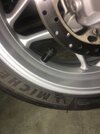dduelin
Site Supporter
I personally think that a TPMS could save an accident and should be considered as equipment no different than appropriate safety equipment like helmet, gloves, boots, armor and abrasion resistant clothing. Tire valve mounted systems with external sensors should not be mounted on rubber valve stems unless some method of bracing the valve stem is employed. Replacing rubber stems with metal ones bolted into place from the inside are recommended but using a compression tube can brace a flexible rubber valve stem from side-to-side movement that will stress the stem. When I bought a used motorcycle in 2019 the tires were no where in need of replacement but I was going to add a TPMS almost as soon as I got the bike home. I took a plastic cap from a Sharpie magic marker and cut it into a tube whose length was where the sensor compressed the tube lightly against the rim. This compression tube kept the valve stem in column until the tires needed replacement and I could replace the rubber stems with 83 degree aluminum ones. With metal stems in place the 5 gram sensors mount directly onto the valve stem.
Some riders prefer the metal T-valves where the sensors mount on one threaded portion and a regular valve cap screws onto the valve itself. These are very practical but I don't like the look of them. I don't find removing the sensor to add air an onerous task - it's no different from removing and replace the standard valve stem cap which I have done for many years. Yes, a few ounces of air pressure is lost when replacing the sensor but if I want 38 psi in the end I put 38.5 psi in the tire and expect it to settle to ~38 psi when the sensor is screwed on.
Compression tube over the rubber stem and under the sensor:

Some riders prefer the metal T-valves where the sensors mount on one threaded portion and a regular valve cap screws onto the valve itself. These are very practical but I don't like the look of them. I don't find removing the sensor to add air an onerous task - it's no different from removing and replace the standard valve stem cap which I have done for many years. Yes, a few ounces of air pressure is lost when replacing the sensor but if I want 38 psi in the end I put 38.5 psi in the tire and expect it to settle to ~38 psi when the sensor is screwed on.
Compression tube over the rubber stem and under the sensor:

Last edited:


